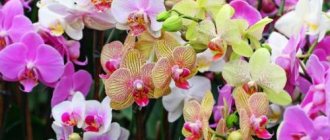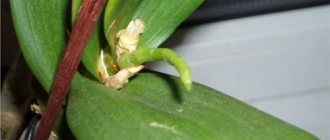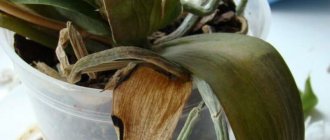The orchid does not grow or bloom, what should I do to make it bloom? When development stopped
If the orchid has stopped blooming, does not form flower arrows and does not produce leaves, you need to analyze the conditions in which the plant is kept. Sometimes it is enough to change watering, add lighting or bring the temperature back to normal and the problem of lack of flowering is quickly solved.
Substrate
In order for an orchid to bloom, it is important to grow it only on suitable soil. Regular soil is not suitable for this flower. It absorbs a lot of liquid and contains high concentrations of minerals. Also, a substrate based on sphagnum moss is not suitable for cultivating orchids. It has a high moisture capacity and can cause rotting of the root system.
Important!
If the soil is not selected correctly, a putrefactive process in the roots will necessarily develop. A diseased epiphyte does not bloom.
Sometimes the reason that flowering does not begin is the unbalanced mineral composition of the soil. With a high nitrogen content, the root system and greenery grow. Increased phosphorus content is important to encourage flowering. To feed an orchid, do not use conventional mineral complexes. This plant needs special, liquid forms, which are applied before the peduncle begins to grow. When the peduncle and buds form, you need to stop feeding the orchid.
How to distinguish the root from the peduncle of an orchid: care recommendations An orchid is a fascinating and unusual flower. Phalaenopsis grows in many homes and is quite popular. For…
Lighting
Most varieties of orchid plants bloom only with prolonged light. They need a lot of indirect light to bloom. Direct ultraviolet rays are unacceptable, as they cause burns on the leaf plates. Daylight hours for epiphytes last 12 hours. Therefore, in autumn and winter it is increased artificially by illuminating the flowers with phytolamps.
Temperature and humidity
The tropical forest in the homeland of epiphytes is humid and warm. Therefore, when cultivating an orchid in an apartment, you need to create the same conditions for it to bloom. In summer it is kept at temperatures from +15 to +30 degrees. In winter, the suitable temperature range is from +20 to +23 degrees. To make a phalaenopsis orchid bloom, the fluctuation between day and night air temperatures must be 5 degrees.
Proper watering
Beginning gardeners often get carried away and water the orchid too much. Therefore, the flower does not experience a physiological need to bloom. Under natural conditions, abundant irrigation of the flower occurs during the rainy season, when the orchid begins to grow roots and leaves. Excess moisture often provokes putrefactive processes, which can also cause a lack of buds. To eliminate rotting, the affected parts of the roots are cut off, these places are treated with activated carbon and the orchid is transplanted into a fresh substrate.
Unregulated application of fertilizers
There are times when, it would seem, the orchid is illuminated correctly, you water it regularly and generally try to take care of it, but still the orchid does not grow leaves and new leaves do not appear. The reason for this may be a simple lack of necessary nutritional components. An orchid most often needs potassium and phosphorus mixtures, so it is imperative to saturate the substrate with them.
Prepare the solution according to the instructions. But if you plan to simply spray the leaves with it, the concentration of the mixture should not be high so that you do not harm your indoor plant.
The need for fertilizing is indicated not only by the absence of young foliage, but also by the appearance of yellow and brown spots on the lower leaf blades. You need to apply fertilizers gradually: saturate the soil with nutrients during watering for 3-4 weeks, and you will soon see the active growth of your orchid begin.
Take care of the plant and it will decorate your home for many years.
Similar articles
Why do the leaves of a home orchid burst?
Why do orchid leaves turn black and how to stop it
Why did the orchid's leaves begin to turn yellow and how to stop it
Why do orchid leaves suddenly lose turgor and wrinkle?
The orchid grows, but does not bloom, what to do to make it bloom. Analysis of orchid keeping conditions
When buying a flower, you need to ask a specialist for an explanation of what variety it is and the characteristics of its cultivation. Phalaenopsis orchid, the most unpretentious variety that tolerates light shading. But there are orchids for which a south window is suitable, and even summer heat is tolerated well by them. An orchid does not bloom if the conditions of its maintenance are violated.
You should always place a saucer of boiled water next to the orchid. Place a clove of garlic in the substrate.
If the flower was purchased in a store, and it was already blooming, and the arrow turned yellow, then the rest period can last up to a year. If the plant is grown from children, then it will take more than two years to wait for the first flowering. By this time, the root system will gain strength and the orchid will produce 5-6 leaves. Early flowering will weaken the beauty.
Why doesn’t an orchid bloom at home after transplantation? When should we expect the first arrow? The transplanted plant initially builds up its root mass within six months. Afterwards, aerial roots develop and leaves grow. Flower buds are formed in the axils. The initial period of plant development in favorable conditions contributes to the laying of a larger number of flower stalks.
Let us remind you how to properly maintain an orchid:
- The roots are well developed, green, some of them are located on the walls of the transparent pot, some are at the top, absorbing moisture from the air.
- The substrate does not contain fresh bark, sawdust or manure.
- It is better to keep the lighting diffused.
- The difference in day and night temperatures when planting flower stalks should be at least 5 degrees.
- Fertilizing with liquid fertilizers depleted in nitrogen once every 10 days before the arrow shoots.
The conditions for laying flower buds are listed, but biological requirements for the maintenance of orchids must be observed.
What to do if the orchid does not bloom or develop well? It will be necessary to provoke the release of the arrow. The aerial root and the arrow look the same at first. But the tip of the arrow is rounded, and at the root it is sharp, as in the photo.
What is turgor?
A healthy orchid leaf is dense, elastic, erect, covered with a light waxy coating.
Such qualities of leaves are provided by turgor - a phenomenon in which the cell membrane is in a tense state due to the pressure of the fluid inside the cell.
A normal level of pressure is provided by water molecules penetrating the membrane, and the cytoplasm of the cell is pressed against the membrane.
Turgor provides:
- normal functioning of the plant;
- height;
- movement of substances;
- evaporation;
- opening of leaf stomata.
Leaves that have lost turgor are called flaccid , flabby, drying out, wrinkled, while the orchid has soft leaves without elasticity.
Phalaenopsis orchid does not bloom, what to do to make it bloom. How and when does the phalaenopsis orchid bloom?
So, first we need to understand one botanical feature of the development of our tropical guest. When does the phalaenopsis orchid bloom - the answer to this question hides the accompanying answers to all possible questions of inexperienced gardeners regarding why the orchid does not bloom for a long time. So, the phalaenopsis orchid blooms for the first time no earlier than 2 years from the moment of its planting. Therefore, if a flower is planted with the help of a child, then you should wait for at least 6 full-fledged leaves to form and then sound the alarm.
Immediately after planting, the plant begins to build up its root mass. Depending on planting conditions, this may take at least 6 months. And only after this the development of aerial roots and leaf mass begins. This is a very important time, since flower buds of future flower stalks are laid in the axils of new leaves. Therefore, as soon as the tops of new leaves begin to appear, you should begin actively feeding with mineral complexes. But be careful. It is best to exclude nitrogen from fertilizers or buy formulations where it is contained in the lowest ratio. Phosphorus, potassium and magnesium are needed to lay future flower stalks.
Another important point regarding the question of when orchids bloom. This tropical plant has no concept of changing seasons. In principle, it does not know that here, in our latitudes, there is winter and the time has come to shed the leaves and stop flowering. The phalaenopsis orchid is not particularly sensitive to the length of daylight hours, since under natural conditions it grows under the cover of dense foliage of the tropical forest. Therefore, the phalaenopsis orchid can bloom without interruption for up to 10 - 11 months. The time when it throws out a peduncle depends entirely on the skill and experience of the grower.
Growth after transplant
Mature plant
After a properly transplanted plant, it takes a month to adapt to the new location and substrate , after which it begins to grow, releasing a young leaf. The root system also slows down its growth for some time in order to adapt to new conditions.
kids
The development and growth of the baby is slowed down at first, but if certain conditions are created, it will begin to grow in a month. And at this moment it will need to be supported and fed with the necessary nutrients for growth.
Children who are separated begin to grow only after a month.
After resuscitation methods
If the plant was in intensive care, it means that it was sick and at the moment its strength was significantly depleted. To help the plant during recovery, it can be treated with zircon or succinic acid . But with good immunity, the first growth can be expected in a month at best.
The orchid grows leaves and does not bloom.
belong to plants that are valued for their magnificent appearance.
That's why they buy them. It’s a shame when plants, having shed their withered petals, are in no hurry to delight again with a riot of colors, only releasing new leaves month after month. Experienced flower growers know that this is not a whim of an overseas guest, but a normal reaction to the conditions of detention! If the owner does not correct them, then he may never wait for new flower stalks to appear. There are two ways:
- . It consists of artificially creating ideal conditions for the rapid ripening of flower stalks using supplementary lighting and humidity changes, and applying a large complex of fertilizers. Used in the industrial cultivation of orchids for retail chains. Suitable for experienced flower growers who are engaged in forcing buds by a certain date;
- Traditional way. Ensures natural life cycles. It does not exclude additional illumination with phytolamps, compliance with humidity and temperature regimes, and application of fertilizers, but does not accelerate the natural rhythm of plant development, but brings home maintenance closer to ideal conditions. Recommended for beginning gardeners.
Is your plant healthy?
Only a healthy plant can bloom. If they do not appear for a long time, it is necessary to check the condition of the pet, its roots and leaves. They will tell you:
- unpleasant, putrid smell from a flower pot;
- slimy, falling apart roots;
Only after healing can you expect a full growing season!
The right look
If the pet is healthy and happy with the living conditions, it looks like this:
- tightly wraps the roots around the substrate and does not wobble in the pot;
- the roots are strong, elastic, light or dark green in color;
- pseudobulbs smooth;
- the leaves are even, of the same shape and size, glossy, smooth, elastic, without plaque, brown or black spots.
With such data, we can expect the long-awaited flower stalks to appear soon.
This is what a healthy orchid looks like.
Reasons why an orchid does not bloom, but only leaves grow
If a close examination shows that the pet is generally healthy, but does not bloom and only produces foliage, then the reason must be sought in the conditions of detention that were created for it:
- Lighting. Most species require additional lighting to increase daylight hours. This provides comfort mode. If a pot with a light-loving specimen stands on the north side of the house or occupies a place in the back of the room, then it lacks light. This may be indicated by fairly elongated stems, leaves that have acquired a thick dark green color;
- Drainage. Perhaps its layer is not sufficient to protect the roots well from stagnant water and ensure respiration;
- Root color. The florist uses it to navigate when it has arrived. Healthy roots have a rich green or grayish-pearl color. Brown color is a signal of waterlogging or hypothermia;
- Watering. The correct regimen is very important. It is worth analyzing how well the irrigation schedule corresponds to the natural rhythm? Are dry periods observed? Is the plant over-watered?
How to determine the need for watering.
- Nitrogen fertilizers. It is necessary to evaluate how intensively they are used? This is an important part of agricultural technology, but it is important to remember that each period of life has its own healthy amount of microelements. Nitrogen fertilizers promote the growth of green mass, but they do not ensure the formation of flower stalks.
Important! Only a healthy plant that has an ideal atmosphere close to natural will bloom!
Measures to eliminate them
Having identified the reasons for the lack of flowers, you should begin to create a favorable atmosphere for the growing season. So, we tell you what to do if the plant produces only leaves without a peduncle:
- Selecting the right substrate. In some cases, it should be replaced with a fresh one or something more suitable for the given purpose. Ideal components - steamed, dried pine bark, coconut fiber - should ensure rapid drying and breathing of roots. Soil, as a rule, is not required. On the contrary, its presence can destroy the plant;
- Organization of proper watering. The ideal method is to immerse the flower pot in a tray of water for a few minutes. Then the pot is taken out, the water is allowed to drain, and it is put back in place. Experienced gardeners water in the usual way: from above over the ground, while making sure that water does not accumulate in the pan. Watering should be done approximately once a week. It is advisable to pre-settle the water for 24 hours;
- Additional lighting. If the exotic is located in the back of the room, on the northern windowsill, or it is planned to artificially stimulate its flowering, then daylight hours should be increased for it using special lamps;
- Choosing the optimal location. It is best to place flowers on eastern and south-eastern windows. Some species, for example, can live in the back of the room if the room is bright enough and the windows are not darkened by blinds or curtains;
- Proper feeding. Extremely important for the formation of flower stalks! To stimulate, the proportion of nitrogen decreases and the content of phosphorus and potassium increases. You can use ready-made complex preparations or add microelements separately. It is important to follow the regimen and dosage, since exceeding it will lead to the opposite result - flower disease.
Never exceed the recommended dose of fertilizer.
Stimulating flowering with stress
If the orchid is healthy, has had enough rest, and is in ideal condition, then it is called using the stress method - using a temperature drop mode or artificial drought:
- Temperature difference. The orchid is taken outside or onto a glassed-in balcony at night. Night air temperature should be at +16 C, not lower. During the day, the potty is returned to the room. The cycle continues for one to two weeks, after which flower stalks should appear;
- Drought. The intervals between irrigations are approximately doubled. It is important to remember that during this period the leaves are not sprayed or fertilized to create the effect of complete drought. The peduncle will appear in one to two months. After this, they return to normal watering mode.
Important! It is impossible to constantly use stress stimulation of flowering, as this will lead to exhaustion of the plant and, possibly, its death! A period of rest and rest is mandatory!
Useful
You will learn about preparing a substrate for an orchid yourself from this video: The following video talks about proper watering of orchids: This video is dedicated to feeding orchids: From this video you will learn how to make orchids bloom:
Conclusion
Caring for orchids requires care and discipline. The florist should immediately create an optimal atmosphere for the green pet. For this:
- when purchasing, find out what type of exotic you are purchasing;
- clarify the features of the regime;
- so that the information is not forgotten over time, you can attach a sign to the pot with the name of the orchid, symbols indicating the requirements for watering, light, and temperature.
Under ideal conditions, the orchid will certainly delight you with beautiful blooms on a regular basis.
How to restore turgor in case of overheating?
When overheated, the leaves droop, buds and flowers crumble, become limp, wrinkled, and red and purple spots/stripes appear.
If overheating occurs, then the orchid should be removed deeper into the room and left alone for 2-3 hours.
IMPORTANT ! You should not immediately spray the leaves or water the orchid; first it must cool down .
Heated leaves cannot be immediately cooled with water; this can cause damage and death of their tissues (yellowing, the appearance of glassy, water-filled areas, etc.).
In many cases, it takes up to 3-4 days to restore water balance.
In order to avoid repeated overheating of the orchid, you need to choose a different location.
Prevention measures
After studying the causes of a plant disease, it is imperative to develop a number of preventive measures that will subsequently help avoid further mistakes and prevent them from appearing again. To do this you need to follow the following rules.
It is necessary to fertilize the orchid only with those compounds that are sold in specialized stores.
It is important that their concentration is minimal. In addition, it is not recommended to apply fertilizers for the first few months. Water the flower with clean water.
This can be distilled, boiled or well-filtered liquid. It is imperative to monitor the change of soil, and you need to buy it in flower shops. Observe temperature conditions. The temperature should not be lower than 15 degrees and not higher than 25. Do not forget about proper lighting and buy good and powerful lamps fixed under the ceiling or on the windowsill. The container purchased for the orchid must be appropriate. That is, it must be transparent so that the roots are constantly illuminated.
To summarize, we can say that you can cope with the problems that arise when caring for an orchid at home. In addition, you should not immediately panic if the leaves begin to fall, because this can happen naturally, and a similar situation will not be reflected in the flowering of the orchid at all. In just a few months, your pet will delight your household with its flowers and fresh green shoots.
You can learn further about how to reanimate an orchid without leaves and a growing point.
Aftercare
Depending on the extent of the damage to the orchid, the duration of its recovery period will also depend. This can take from six months to a year, so you should be patient and care for the plant in such a way as to make its recovery period as easy as possible and resume all life processes. To make the flower develop faster, you can wipe the leaves with a solution that activates and accelerates growth. For optimal results, it is enough to do this 1-2 times a week.
It is better to restore an orchid in the warm season. In winter, the recovery procedure is extended over a longer period. Depending on the problem you encountered, you may need to transplant the flower into a new container. It is best to grow an orchid in a pot that is suitable for the specific plant in size.
Planting in pine bark is considered the most acceptable option, since it:
- makes the soil breathable;
- is moisture-intensive, makes it possible to remove excess moisture;
- has an antiseptic effect due to lignin;
- it contains a lot of nitrogen, ash and oxygen, wax, vegetable fats and other trace elements and mineral acids.











